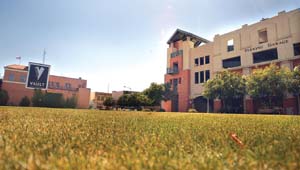
At a prime location for downtown
– where city leaders say a flourishing enterprise could anchor
the local economy – stands freshly cut green grass, occasional war
protesters and aged oil drizzle from summertime car shows.
At a prime location for downtown – where city leaders say a flourishing enterprise could anchor the local economy – stands freshly cut green grass, occasional war protesters and aged oil drizzle from summertime car shows.
It’s the corner of Fourth and San Benito streets, an intersection of two state highways and a potential hub of business activity. And it’s where a city of Hollister-owned vacant lot sits without the foot traffic that could uplift the downtown’s fizzling flow of cash.
Now the city’s Redevelopment Agency is recruiting commercial developers to build a multi-storied structure. Preferably, officials say, one that can attract a national retail giant. City Manager Dale Shaddox has expressed a desire to attract companies such as Orchard Supply Hardware, Applebee’s and Borders’ books.
The Hollister City Council will consider approving the RDA’s extensive development marketing plan for the lot – one that makes Hollister sound like an oasis of economic opportunity – at its next regular meeting May 17.
The Council was slated to approve the action Monday. But a clerical glitch pushed it off until the following meeting, which Avera said won’t affect the desired timeline.
It’s the right time to begin recruiting potential developers, according to officials, because the sewer spill-induced building moratorium is scheduled to end in about 18 months. And the planning and construction process would take about that long to complete.
“Right now’s a good time to see what’s out there and see who’s interested in that property,” said RDA Director Bill Avera.
Avera compiled the promotional package that would be sent to an extensive list of developers – many that have previously worked with other cities’ RDAs, according to Avera.
The RDA plans to accept basic information about developers before narrowing the list to “two or three firms.” From there, the city will request more detailed plans for a potential project, he said. Avera hopes to establish an “exclusive negotiating agreement” (ENA) with one firm by the end of August, he said.
Hollister’s off to a good start, he said, because several developers have already shown interest in the site. One even produced a rendering of a three-story building – with a corner anchoring store towering over the intersection – a sketch Councilman Tony LoBue at Monday’s meeting called an ideal culmination.
But mere interest, as local history shows, doesn’t necessarily produce results – even for what Avera called “the most sought after corner in town.”
The RDA has owned the property since the early 1990s, when it purchased several buildings that were “determined to be dilapidated,” Avera said. Some of those damages, he acknowledged, stemmed from the 1989 Loma Prieta earthquake.
The plan was to tear down the structures, build a parking garage and attract a developer that could energize downtown.
More than a decade later, the city has a lonely $4 million parking garage – one that is often a subject of officials’ frustration because of its lack of use – and no adjoining structure.
At several points since owning the property, the city entered into ENAs with an array of different developers.
First in the early part of the decade, a developer was on the verge of building a movie theater there, Avera said. But when Premiere Cinemas concurrently progressed with its own plans, the city conducted a study revealing that two theaters couldn’t survive. So the project sputtered.
A couple of years later, another developer’s ENA to build a 105-room hotel faded. And in the late ’90s, an idea to construct a performing arts center dissolved when its financial supporters backed off. President of the Center for the Arts organization, restaurant owner Ignacio Velazquez, attributed its demise to negative publicity and a worsening recession.
Then in 2002 the moratorium hit. And with it, the city’s ability to muster interest from builders faltered.
“It’s hard to market a property that can’t be built on,” Avera said.
But now renewed confidence, officials say, is authentic.
Not only is the city hovering near the 40,000-population threshold that causes retailers to lick their chops, but an immigration of upscale residents in recent years has also produced a more deep-pocketed demographic.
“They are people that are willing to spend,” LoBue said.
Bruscia also pointed out that more growth is inevitable. And a new sewer plant going online in late 2005 can support a managed increase in population, he said.
“There’s definitely some interest,” Bruscia said. “It’s going to come.”
He believes the city can attract national players; some, such as Gottschalks and Denny’s, he said, have already expressed some interest. Home Depot has also been intrigued in the past, but probably won’t consider Hollister until the moratorium is lifted, according to City Manager Dale Shaddox.
Whether national retailers will move to downtown Hollister is not so clear, officials say. In a move that Avera called coincidental, the RDA director on Monday presented a plan to the Council that shows how business vacancies downtown are on the rise.
The Council approved a program that night to award new tenants with financial incentives if they move into empty spaces.
Regardless, Avera said, the city remains confident that new spaces – if they’re the right spaces – are needed. He mentioned the Klauer building downtown at Seventh Street as one that has proven, since its opening in 2002, to be successful.
And the corner of Fourth and San Benito streets, he said, “is set up to succeed” as well. For now, it will remain occupied by protesters on Friday afternoons, monthly summer car shows and other sporadic events.









